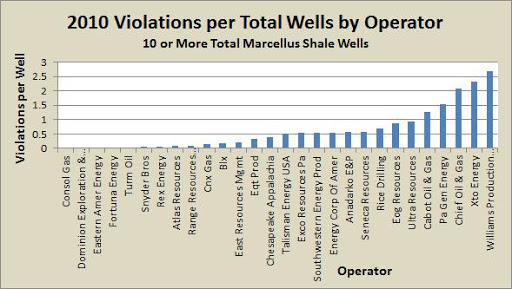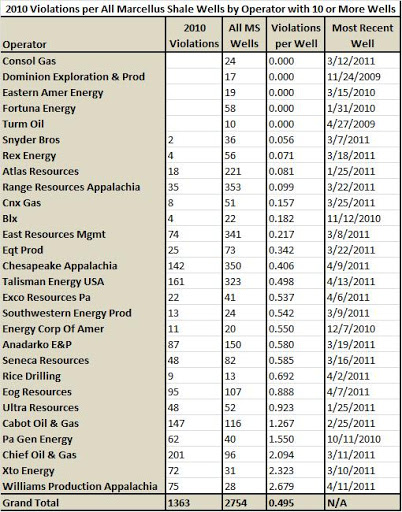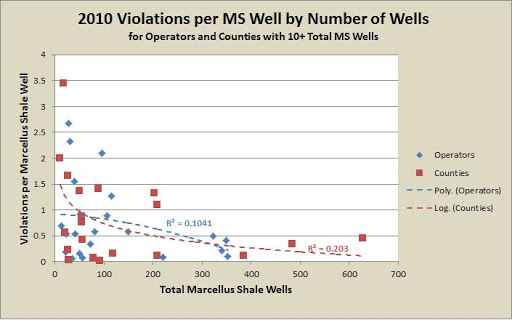2010 Fines for Marcellus Shale Violations
In yesterday’s Post-Gazette, Don Hopey discussed an analysis by PennFuture which saw a notable decline in fines in the first quarter of 2011, as compared to the same period last year. The implication is that the DEP is not backing up violations with fines under Governor Corbett’s administration to the same degree that it did under former Governor Rendell. In the former administration, PennFuture calculated an enforcement action was handed out for every 1.7 violations, and now the rate is one per every 8.7 violations.
I think this is a worthwhile trend to keep an eye on, with the caveat that it is still early in Governor Corbett’s tenure, and that violation data varies widely from month to month.
It is also possible that the DEP under the Corbett administration will still issue fines for significant events. In fairness, I came across this article of fines issued over eight months after an incident by the DEP under Rendell. I think we need more time to see if the new administration’s patterns of reduced fines per violation hold.
That said, Marcellus Shale fines and enforcements under the Rendell administration is hardly a sensible target for comparison. The fines issued in 2010 were at once paltry and erratic.
Industry sources indicate that Marcellus Shale wells cost between $5 million to $6.4 million to drill. Last year in Pennsylvania, there were 1,454 Marcellus Wells drilled in the Commonwealth, meaning that the total cost of operations for the year for the industry is somewhere in the mind-boggling range of $7.2 billion to $9.3 billion. How much of that cost was fines issued by the DEP? $775,650.22. Even using the conservative figure of $5 million per well, DEP fines only account for 0.01 percent of operating costs–hardly any impediment at all. In essence, with the change in administration the DEP went from collecting fines in Monopoly money to asking drilling operators to sit down for a while and think about what they’ve done.
Over 45 percent of the fines issued for the Marcellus Shale in 2010 went to EOG Resources, the operator for a major blowout in Clearfield County. That was far from the only major incident in 2010, but the DEP was clearly mad about the incident, posting an entire section about the incident on their website. The $353,400 fined to EOG for this incident went to cover the DEP’s cost of response and investigation.
The two operators with the highest fines issued for Marcellus Shale operation in 2010 are toward the top of companies with the largest number of violations per year. That said, those companies at the very top were fined a significantly lower amount.
When we look at fines per violation, in addition to the same two operators that stood out in the last graph, we see several companies with relatively few violations having a significant number of fines per violation.
From an outside perspective, it is difficult to determine what sorts of factors go into whether or not a fine is issued, and if so, for how much. If the goal is simply to recoup costs of the DEP response and investigation, one wonders why there isn’t a fine more often, since every violation issued costs the DEP some resources to evaluate, process, and issue. And if fines are to act as a deterrent, they should include punitive damages, not just actual costs.
Keep in mind that the $7.2 billion to $9.3 billion range is just for Marcellus Shale wells, which last year represented about half of all oil and gas wells drilled in Pennsylvania. The industry is huge. One way we could have the oil and gas industry benefit all Pennsylvanians is by paying for the expenses of their DEP oversight, through permit fees and fines. That taxpayer savings could then be applied to other programs to help address the overall budget issue. Such an arrangement would be a huge boon to Pennsylvania, and while they might complain, the industry would barely notice if their cost per well went up by a few thousand dollars. Such an arrangement would also allow for the DEP to keep up with a rapidly expanding industry in a time of fiscal austerity that is sweeping the Commonwealth, and the nation as a whole.
- Other sources, such as the Marcellus Drilling News report higher fine totals, but that includes a broader time frame. See Sean Hamill’s Post-Gazette article.







